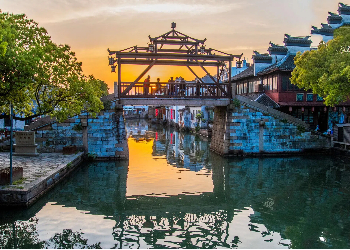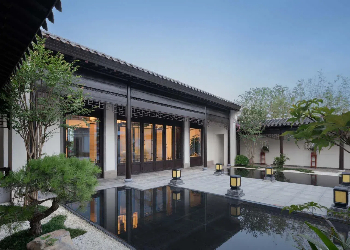Jiangsu Province, a dazzling gem embedded along the eastern coast of China, boasts a unique and temperate climate with four distinct seasons, nurtured by its strategically advantageous geographical location and natural environment. The climatic characteristics here not only showcase the rhythmic beauty of nature but also profoundly reflect the shaping power of regional differences on the climate, resulting in temperature variations and characteristics in Jiangsu that exhibit remarkable regional and seasonal variations.
Temperature Variations Across the Four Seasons
In spring, Jiangsu experiences a gradual rise in temperature, but there is a significant temperature difference between day and night. As solar radiation intensifies, temperatures steadily increase, making the daytime warm and pleasant while nights remain slightly cooler. During summer, temperatures in Jiangsu are relatively high, especially in July and August, where average temperatures often exceed 30°C, with extreme highs reaching above 35°C and occasionally surpassing 38°C. At this time, the relative humidity in Jiangsu is also high, making the weather feel muggy and uncomfortable. To cope with the high temperatures, various measures are taken across Jiangsu, such as enhancing urban greening and increasing public cooling spaces, to provide a refreshing environment for residents. In autumn, temperatures in Jiangsu gradually decrease, but the weather remains sunny and dry, making it an excellent time for travel. In winter, temperatures in Jiangsu are lower, with average temperatures above 0°C, but occasional cold waves can strike, causing sudden drops in temperature. During this period, the relative humidity in Jiangsu is lower, resulting in dryer air. To address the cold weather, Jiangsu strengthens the construction and maintenance of heating facilities to ensure residents stay warm throughout the winter.

Regional Differences in Temperature Variations
The temperature variations in Jiangsu Province not only exhibit distinct characteristics as the seasons change but also showcase significant regional differences. These differences further enrich Jiangsu's climatic landscape and offer tourists a diversified travel experience.
Specifically, the southern Jiangsu region, including cities like Nanjing, Suzhou, and Wuxi, benefits from the natural barrier of the Yangtze River and the mild environment of the Jiangnan water towns. Temperatures here are relatively high, and winters are warmer. Even during the biting cold, one can still feel a unique gentleness and tenderness unique to Jiangnan. Summers in this region are hotter, but due to the high humidity, the air is filled with a moist warmth, adding a touch of softness and comfort to the summer heat. The four seasons in southern Jiangsu, like a gentle Jiangnan woman, tell the story of the seasons in her unique way, attracting countless tourists to explore.
In contrast, the Huaibei region, including cities like Xuzhou and Lianyungang, is located on the Huang-Huai-Hai Plain and has a relatively dry climate. Winters here are colder, with snow-covered landscapes often breathtaking. While summers also bring high temperatures, the lower humidity makes Huaibei’s summers feel cooler and more refreshing compared to the muggy heat of southern Jiangsu, making it a great destination for summer getaways. The four seasons in Huaibei, like a rugged northern painting, interpret the changing seasons with its unique charm, providing tourists with a different travel experience.
These regional differences not only diversify Jiangsu’s climate but also offer tourists more varied travel options. Whether it's the warm and pleasant spring in southern Jiangsu or the cool and refreshing summer in Huaibei; whether it's the cool and dry autumn in southern Jiangsu or the cold and dry winter in Huaibei, each has its unique charm, captivating tourists’ attention. The temperatures in Jiangsu, like an artist of the changing seasons, add endless color and vitality to Jiangsu’s tourism industry in its unique way, allowing every visitor to find their own beauty and inspiration here.
The Best Times to Visit Jiangsu
Jiangsu, a fertile land in eastern China, is renowned for its unique natural scenery, rich historical culture, and enticing cuisine. Whether wandering through ancient gardens or tasting authentic Jiangnan snacks, Jiangsu always offers tourists unforgettable experiences. However, to fully appreciate the charm of Jiangsu, choosing the right time to visit is crucial.
Spring (March to May)
 The Tongli Ancient Town
The Tongli Ancient Town
Spring is one of the prime seasons for tourism in Jiangsu. As temperatures gradually rise, everything comes back to life, and flowers bloom in a riot of colors, dressing Jiangsu in a multicolored cloak. Especially in Suzhou’s gardens, such as the Humble Administrator’s Garden and the Lingering Garden, spring is the perfect time for flower viewing, with cherry blossoms, peach blossoms, apricot blossoms, and more competing to bloom in a breathtaking display. Additionally, spring is the best time to visit the ancient water towns of Jiangnan, such as Zhouzhuang and Tongli, where tourists can stroll through ancient streets and feel the tranquility and beauty of the water towns. Therefore, March to May in spring is an excellent period for tourism in Jiangsu.
Summer (June to August)
 The Taihu Lake
The Taihu Lake
Although summer temperatures in Jiangsu are high, it is the best time to enjoy the water towns. Tourists can choose to visit the ancient towns in the early morning or late evening to avoid the midday heat and enjoy the unique coolness and tranquility of the water towns. Furthermore, summer is the peak tourist season for Jiangsu’s major lakes, such as Taihu Lake and Hongze Lake, where visitors can go fishing, boating, and lotus flower viewing, experiencing the tranquility and harmony of nature. However, due to the high temperatures in summer, tourists need to pay attention to sun protection and hydration to avoid heatstroke.
Autumn (September to November)
 The Mount Qixia
The Mount Qixia
Autumn is another prime season for tourism in Jiangsu. At this time, temperatures are moderate, and the sky is clear and crisp, making it a great time for outdoor activities. Jiangsu’s autumn scenery is enchanting, especially at Mount Tianping in Suzhou and Mount Qixia in Nanjing, where the mountains are covered with red leaves, and the forests are dyed in layers of colors, attracting a large number of tourists to come and see. Additionally, autumn is the harvest season for Jiangsu’s various orchards, such as vineyards and apple orchards, where tourists can pick fruits themselves and taste the authentic flavors of Jiangnan. Therefore, September to November in autumn is another excellent period for tourism in Jiangsu.
Winter (December to February of the next year)
 The Tangshan Hot Spring
The Tangshan Hot Spring
Although winter temperatures in Jiangsu are low, it is the perfect time for hot spring tourism. Jiangsu boasts numerous hot spring resources, such as Tangshan Hot Spring in Nanjing and Tianyi Hot Spring in Suzhou, where tourists can enjoy the warmth and comfort of the hot springs during the cold winter days. Furthermore, winter is the open season for Jiangsu’s major ski resorts, such as Dajingshan Ski Resort in Xuzhou, where visitors can ski, make snowmen, and play snowball fights on the snow, feeling the joy and excitement of winter. However, due to the low temperatures in winter, tourists need to pay attention to cold protection and warmth.
In summary, Jiangsu has distinct characteristics in each season, with unique tourism resources and charm. Tourists can choose the right season to visit Jiangsu based on their interests and schedules, experiencing the local customs and natural beauty of this land.




































